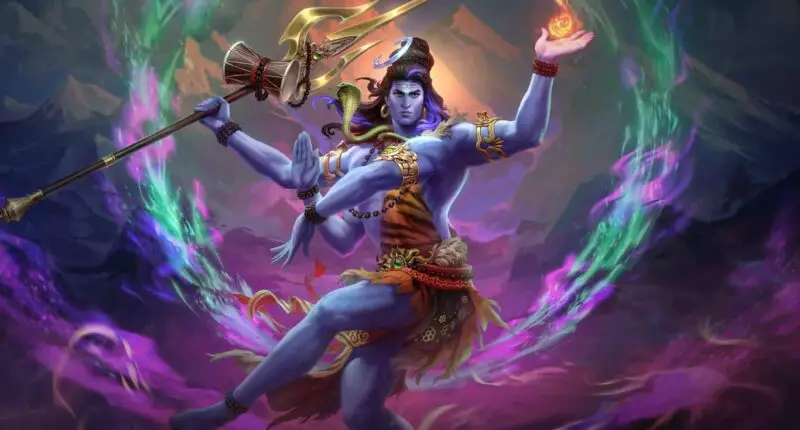The Cosmic Dance of Lord Nataraj, also known as the “Tandav,” is a mesmerizing depiction of the Hindu god Shiva as the Lord of Dance. This ancient Indian art form depicts the dance of creation, preservation, and destruction, symbolizing the cyclical nature of life and the universe. The Nataraj statue is considered one of the finest examples of Indian sculptures and has become an iconic representation of Hindu culture and spirituality. In this article, we will delve into the history, symbolism, and cultural significance of the Cosmic Dance of Lord Nataraj.
Lord Nataraj
Lord Nataraj, also known as Shiva Nataraja, is a Hindu deity who is considered the Lord of Dance. He is depicted as dancing in a circle of fire, symbolizing the cyclical nature of life and the universe. Nataraj represents the ultimate reality, the truth behind all creation, and is seen as the source of all movement, both physical and spiritual. He is one of the most important deities in the Hindu pantheon and is revered as the destroyer of ignorance and illusions. In his cosmic dance, Nataraj is both the creator and the destroyer, representing the dynamic balance between creation and destruction in the universe.
The Nataraj Pose

The Cosmic Dance of Lord Shiva embodies several important features and qualities:
- This depiction shows Shiva standing on one leg and lifting his right one, following the tradition of Natya Shastra, as he dances with joyous abandon.
- In his left hand behind him, he holds the symbol of Agni (fire) which represents both creation and destruction. The front hand is either in the elephant hand gesture (Gajahasta Mudra) or the stick hand gesture (Dandahasta Mudra).
- The front hand holds a serpent, symbolizing Abhaya or fearless power, while the other hand behind him holds the Damru drum in the Damaruhasta Mudra, signifying time and rhythm.
- The other parts of Shiva’s body in the Nataraja pose, including his fingers, neck, face, ankles, head, and earlobes, are adorned with significant items.
- Shiva is depicted with three eyes, representing the Sun, the Moon, and the Third Eye, which is the eye of wisdom. Despite the intense pose, he is still depicted with a smile, conveying inner peace and bliss.
- He stands on a lotus platform and is surrounded by a circle of fire, symbolizing the universe and the Prabha Mandala, which in Hindu mythology represents the cyclical nature of life and its creation and destruction.
- The depiction also shows Shiva lifting his left leg and trampling down a small demon called Apasmara Purusha, who represents ignorance and evil, crushing the notion that “ignorance is bliss.” It reminds us that life cannot be ignored or overlooked.
What is Tandav
Tandav is a Sanskrit word that refers to the cosmic dance performed by Lord Nataraj, the Hindu deity of dance and destruction. The Tandav is considered a representation of the cyclical nature of life and the universe, depicting the creation, preservation, and destruction of all things. In Hindu mythology, Lord Nataraj performs the Tandav to destroy the universe at the end of a cosmic cycle, after which it is recreated for the next cycle. The Tandav is also seen as a metaphor for the human experience, with Lord Nataraj symbolizing the soul’s journey through life, from birth to death and rebirth. The dance is depicted in Hindu art and sculptures, and is considered one of the most iconic and sacred images in Hindu culture.
The Significance and Symbolism of Tandav

The Tandav holds significant cultural and spiritual meaning in Hinduism, embodying a rich symbolism that speaks to the fundamental principles of life and the universe. Here are a few key symbolic elements of the Tandav:
- The Circle of Fire: The circle of fire in which Lord Nataraj dances symbolizes the cycle of birth, life, and death, as well as the cycle of creation and destruction. The fire also represents the divine energy and power of the universe.
- The Four Arms: Each of Lord Nataraj’s four arms represents a different aspect of the universe and the human experience. They symbolize creation, preservation, destruction, and the protection of souls.
- The Damaru Drum: The damaru drum that Lord Nataraj holds symbolizes the sound of creation and the vibration of the universe. The rhythm of the drum is seen as the heartbeat of the cosmos.
- The Serpent: The serpent that Lord Nataraj wears around his waist represents ignorance and ego, which must be destroyed in order to attain enlightenment.
- The Foot on Demon: The foot that Lord Nataraj places on a demon symbolizes the victory of good over evil, and the triumph of truth over ignorance.
Lord Nataraja’s Influence and Impact on the Western Society

The significance of the Cosmic Dance of Lord Shiva has been recognized by scientists globally who suggest that the essence of existence is merely the movement of energy particles in different forms. Hence, following this creation with a graceful dance form which is enchanted, unique, and magnificent in its nature.
In 2004, the European Organization for Nuclear Research (CERN) in Geneva unveiled a two-meter-tall model of the Cosmic Dance of Shiva, depicting the deity in a dance pose. The dancing Indian god symbolizes the grand patterns of creation and destruction, and also represents the properties of subatomic particles that are the foundation of the universe, studied by physicists all over the world.
We often question the origin of the Cosmic Dance of Shiva. Is the universe comprised of energy particles that follow the laws of matter and energy, or is it still challenging to understand the true nature of the universe and its existence?
There are many theories attached to these questions with no definite answer, but there have been sages and spiritual leaders who have stated that everything is as simple as it may seem mysterious. It is all about experiencing this Brahman (universe) within oneself.
The Cosmic Dance of Shiva is believed to be the source of energy from which everything originated. It represents the rhythm of life that one needs to flow with to understand the universe, to attain enlightenment, and to know oneself from within. It has been repeatedly said by various yogis that life, oneself, and the universe are part of the same scheme, and that it is all about finding the dance, rhythm, and flow of life which can lead to ultimate unity.
Also Read: Symbolism and Meanings Behind Hindu Rituals and Ceremonies



